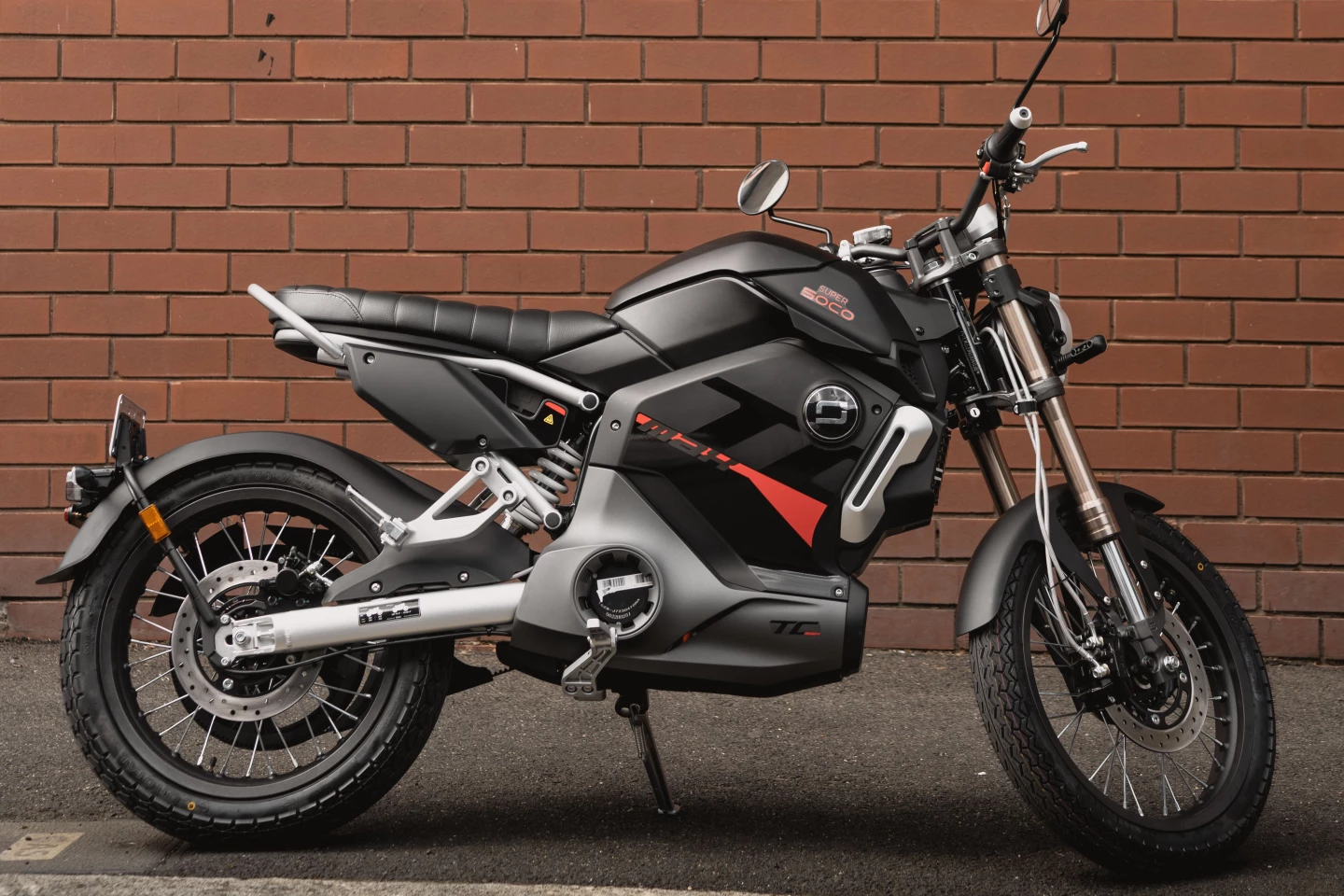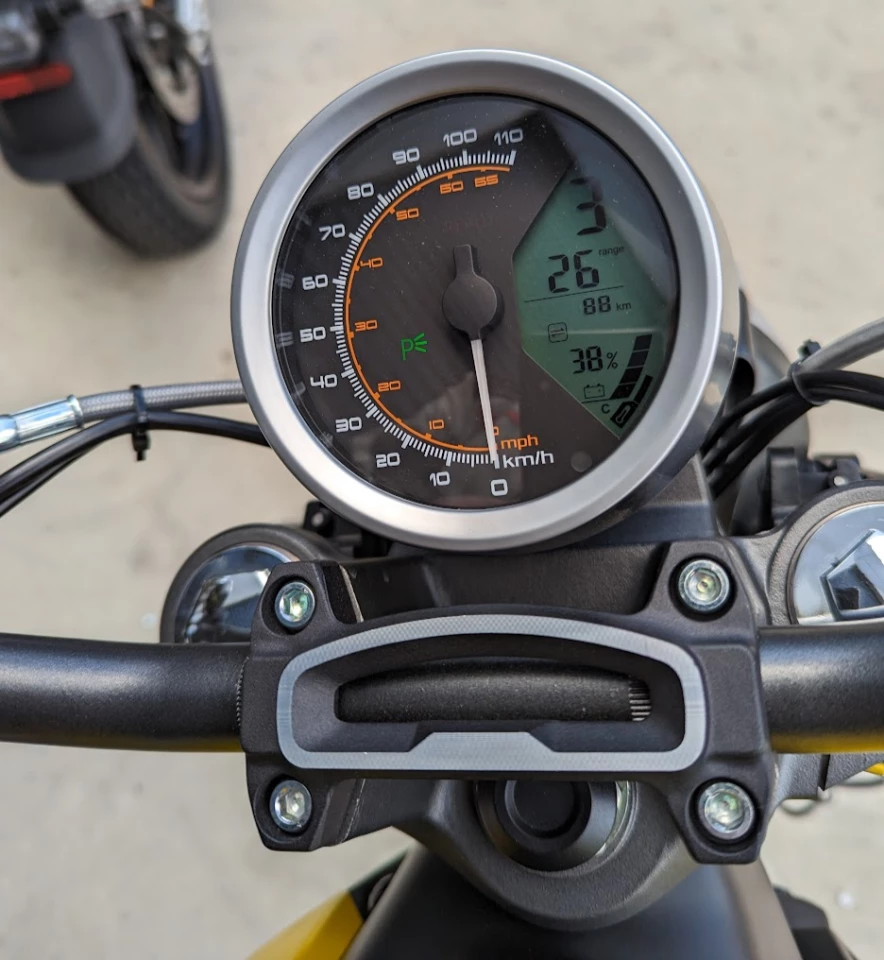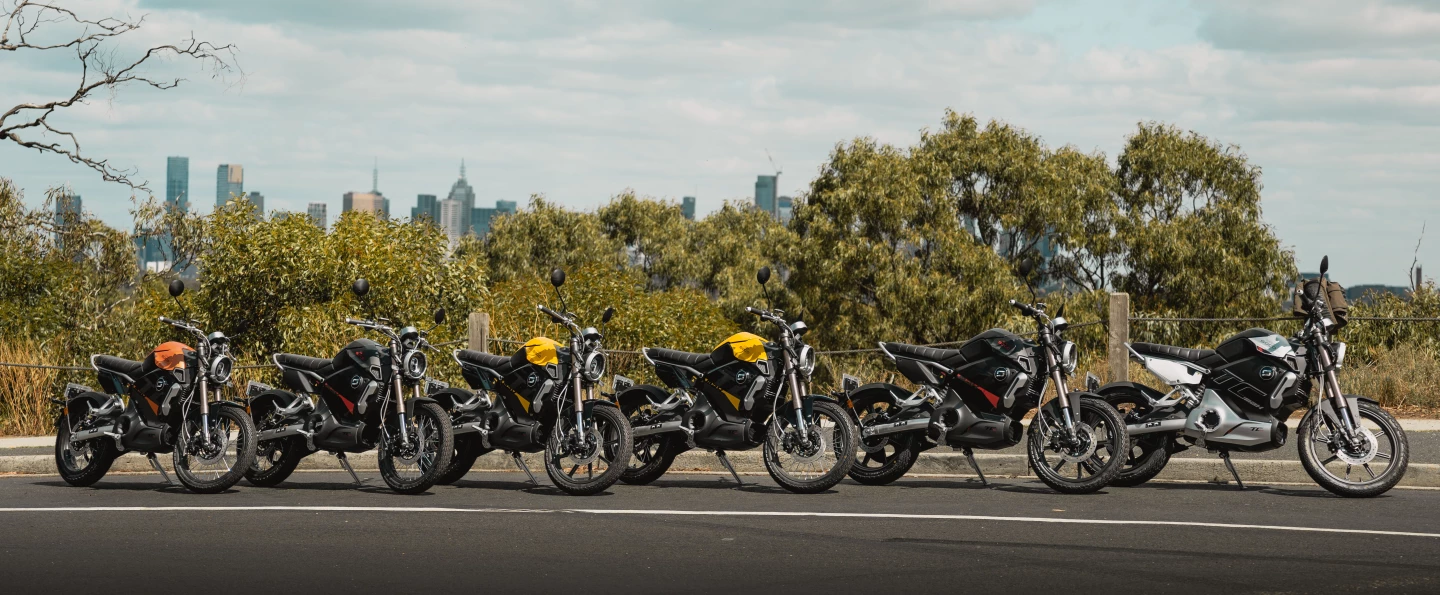Super Soco has targeted this neat-looking electric cafe racer at the sweet spot for suburban commuting, aiming to give it enough battery and poke for practical daily riding with an approachable price tag. We spent an afternoon on board the TC Max.
The TC Max is a compact and approachable little bike, weighing just 100 kg (220 lb) and offering a 770-mm (30.3-in) seat height that should make it accessible and comfy for shorties. As a result, a big goober like me, weighing more than the bike, might make it look like I sat on a rollerblade in the press photos.
However it looks, though, riding it didn't make me feel like a circus bear on a tricycle. It's certainly a small and lightweight bike to sit on, but the seating position is plenty comfy enough for the kind of distance it's designed for. I doubt that'd hold up for a passenger, mind you – there's footpegs and a rear grab handle for a pillion, but there's precious little space on the back of that sweet-looking bench seat if the rider's packing my level of badonkadonk.

Instead of using a rear wheel hub motor like the smaller, lighter, cheaper Super Soco TS urban commuter, the TC Max runs a central electric motor, with power transferred to the back wheel through a belt drive. The motor peaks at 5.1 kW (a tad under 7 hp), and appears to handle about 3.9 kW (5.2 hp) continuously without overheating. Torque is rated at an impressive 180 Nm (133 lb-ft), but it's a single-speed bike geared for a top speed around 95 km/h (60 mph), so you needn't worry about getting wheelied off the back of it.
Indeed, wheelies only appear possible when holding the back brakes on and physically lifting the bike at the handlebars. This was attempted repeatedly by yours truly and several of the other moto-journo-clowns assembled at the Australian post-COVID launch event, with varying degrees of success and hilarity.
Accelerating away from the lights, the TC Max has enough grunt to separate you from most four-wheeled traffic. Motorheads like myself are always going to pine for more power, and there's little to fear at the throttle stop here, but commuter-focused riders will find it gets the job done and doesn't feel dangerously underpowered like some machines certainly can. If your trip to work includes stretches of highway, it'll handle anything up to 80 km/h (50 mph) with aplomb, and take you close to 100 km/h (62 mph) if you're both patient and aerodynamic.

These higher speeds, however, will definitely drain the battery faster, and that's worth factoring in if you're looking at a bike like this. Super Soco has a wacky solution for this, in the form of a 3-way mode switch. This doesn't appear to affect the power curve in the way you'd expect on most motorcycles; instead, modes 1 and 2 place soft limits on the bike's top speed, while mode 3 lets you go for broke. Interesting idea, but to my mind, sometimes you need to accelerate for safety reasons, and I felt safest leaving it unrestricted at all times.
The TC Max's battery pack – removable if you can carry 22 kg (48.5 lb) – holds 45 Ah at 72 volts for a total capacity of 3.24 kWh. It certainly doesn't sound like a lot of battery – I've got an ebike with about 1 kWh of energy aboard – but with the bike's light weight and modest power output, Super Soco reckons a single five-hour full charge is good for as much as 92 km (57 miles) of riding if you keep the speed down.
As befits media goons, we did not keep the speed down, or spare the horses. Indeed, I'd wager most of us went wide open on the throttle every time we accelerated, and there was plenty of to-and-fro work doing laps for the photographers. As the heaviest rider in the group, my battery probably took the biggest beating, and after about 40 km (25 miles) of harsh treatment, my dash showed 38% of battery remaining.

So a lower range estimate around 60-70 km (37-44 miles) seems about right, provided you're riding suburban streets rather than the freeway. According to Zippia, the average American two-way commute is about 66 km (41 miles), so this range figure will suit a decent chunk of people.
We did have a chance to throw this machine into a few corners, and while it's certainly not sprung for a heavyweight like me, I don't have many complaints about the handling. It steers lightly on slim 90- and 120-section tires and feels generally unfussed in a longer turn. The brakes are non-ABS, but it's a combined system, so you can yank on one or both levers and pull up impressively smartly on a good surface.
More importantly for this kind of machine, the turning circle is tiny, and the handlebars and rounded mirrors are narrow enough to make it a capable and confident lane-splitter for filtering through traffic.
In terms of complaints, well, oddly enough, for an electric motorcycle company I think Super Soco can definitely improve on its electronics. The largely redundant mode switch is one example, but there's others. The indicators work on a fiddly three-position switch without a cancel button. The dash can be too reflective, making the idiot lights, battery and trip information hard to see on a sunny day. The analog speedo fits the cafe racer vibe, but a big digital number would probably deliver the information better.

There's keyless ignition, but it's not as simple as walking up with a fob in your pocket, arming the bike and riding off. Instead, you need to press a button on the fob to unlock the bike, then a button on the tank to turn it on. Pressing this button again locks the bike, and that means if you accidentally switch it off at the lights – or your riding buddy non-accidentally hits your off button, a frantic pocket-fumbling process will ensue before you can move again.
This situation is not improved by the built-in alarm system, which chirps merrily at you if you attempt to move the bike in this state, and also attempts to resist any effort to roll the bike away, by placing some electric drag on the rear wheel. It's about the least intimidating bike alarm I've heard, and it made a bit of a nuisance of itself at the launch event. I'd be checking to see if it can be disabled, and just getting a bike lock.
And then there's the welcome music. Switch the TC Max on, and it plays a happy, dorky little welcome song. It makes a sadder noise that sounds like an error beep when you turn it off. I am by no means any kind of arbiter on what's cool, but ... I'm pretty sure that's not cool, and it punctures the aura the bike's looks are working hard to create.
The looks are important here; this is a handsome machine, particularly in black or yellow. Euro-designed and Chinese-built, Super Soco is hoping to tempt riders away from the scooter market, and the retro-futuristic look of this bike needs to overcome the fact that it doesn't offer cavernous storage space big enough to fit a helmet or two. Indeed, you'll get a wallet, a phone and maybe some gloves into the storage compartment under the flip-top "tank" lid, but that's about it. Best get a nice backpack!
The price is also important. The TC Max retails for around AU$7,990 (US$5,350) in Australia, or AU$8,290 (US$5,550) if you upgrade to spoked wheels instead of alloys. It's not currently available in the USA, but there are dealerships throughout Europe.
How the price hits will depend on local competition; there's not much in my region that looks like this and offers a similar 125cc-ish level of performance. A Honda Grom or similar would be cheaper to ride away, but it's worth factoring in that there's very little maintenance to do, and a full battery costs about a buck or two, so running costs should be a fair bit cheaper than combustion bikes over a year's riding.
All up, the TC Max is a little on the small side for me, but I'm an outlier and it'd make a fun and practical ride suitable for a lot of commuters. If you jive with the looks, and can deal with the little welcome song and the key fob thing, it seems like it'd be easy to live with, and it's well worth a test ride as a friendly suburban getabout with a dash of style. Check out a short video below!
Source: Super Soco












